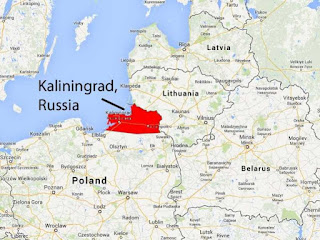Kaliningrad (née Königsberg) is an exclave, not an enclave. Lately much discussion has been devoted to NATO borders with a resurgent Russia in Estonia, Latvia and Finland, but not much is said about Kaliningrad, a Russian territory (and exclave) surrounded entirely by Lithuania and Poland.
Simply stated, Kaliningrad is a Russian (Soviet) city refashioned atop a German city, situated in what used to be East Prussia, and made possible by geopolitical adaptive reuse and ethnic cleansing following World War II.
Here's the short version of the documentary film's tale.
Königsberg, the ancient capital of East Prussia. Founded in 1255, Königsberg had been, in turn, the seat of the Order of the Teutonic Knights, the coronation place of Prussian kings and the birthplace of the philosopher Immanuel Kant. But that Königsberg no longer exists, its historic centre had been turned to rubble by the RAF in 1944, and subsequently occupied by the Red Army after one of the bitterest sieges of the Second World War. The remaining German population was driven out and the city, some to the West, some to exile and an early grave in the Russian East, and Oblast Kaliningrad created. In the official Soviet version, Kaliningrad's history only began in 1946. This documentary commemorates the 750th anniversary of the founding of Königsberg/Kaliningrad with interviews and extensive access to archive films, photographs and historical records. Former Königsberg residents now 'marooned' in the West, young Russians and one of the very few survivors of Königsberg's once-thriving Jewish population provide personal impressions of the city, both in its former glory as the jewel in East Prussia's crown and as a decrepit Russian outpost now incongruously situated within the EU.
The film is somewhat goofy in places, as with the recurring device of a wandering elk), and at places during the first half, the music is badly mixed, but it remains fascinating nonetheless. As a side note, the documentary was filmed beginning in 2004 and released in 2006, and as of 2016, first-hand witness and Königsberg native Michael Wieck is still alive at 88 years of age.
Kaliningrad was a place I couldn't even consider visiting during my 1980s East Bloc jaunts, as it was the port city of the USSR's Baltic Fleet and off-limits to foreign tourists. With appropriate visas these days, one can take the train from Berlin to Kaliningrad. I'd dearly love to do so.
How much is left of the original city, vast portions of which were obliterated during the closing stages of the war, and the initial years of Soviet occupation?
"This includes the ultimate insult to architecture anywhere – the multi-story House of Soviets at the site of the destroyed Königsberg Castle – a concrete apparition so excruciatingly ugly, it has been frequently referred to as the ugliest building in the world. Left unfinished for over 20 years, the exterior was painted light blue and windows were installed, for a visit by then-President Vladimir Putin in 2005. However, the interior remains unfinished and unusable."
Most people living in Kaliningrad today came there from somewhere within the former Soviet Union. In the decade since this documentary's release, younger residents increasingly see their lives and future prospects in terms of proximity to the European Union, not Russia.
This article from 2014 provides an update.
Resurrecting Königsberg: Russian City Looks to German Roots, by Susanne Beyer in Kaliningrad, Russia (Spiegel Online International)
The Allies bombed the Prussian city of Königsberg into the ground in 1944. Residents of what is today the Russian exclave of Kaliningrad, a desolate Soviet landscape, are considering rebuilding the city center to reflect some of its historical German architecture.













No comments:
Post a Comment